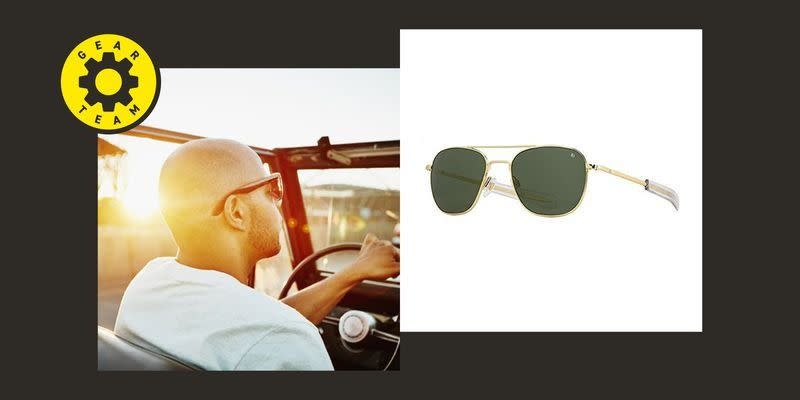Tested: The Best Driving Sunglasses for Road Trips

"Hearst Magazines and Yahoo may earn commission or revenue on some items through the links below."
Driving sunglasses are about much more than looks—what really matters is how they perform. After securing roadworthy shades from the top sunglasses brands, we decided that the best way to put them to the test was by embarking on an epic road trip.
Like the perfect pair of sunnies, sports cars are the embodiment of speed, style, and smiles. To that end, we picked a 2021 Toyota Supra 2.0 to be our chariot. What better way to match the swagger of high-end sunglasses than with this scorching-hot Japanese beauty? Our shades matched the persona of this scarlet slingshot, whether we were soaring along the highway or slowly stalking city streets.
The Car
We were behind the wheel of the 2021 Toyota Supra 2.0 for the trip. Don't let the less powerful four-pot up front fool you; this thing has some serious pep. But rather than torture it on a track, we wanted to test it for the long haul. Not exactly marketed as a "Grand Tourer," it performed shockingly well both inside and out on a great Midwestern route that boasted both long straight swaths and curvy bits that allowed the Supra to flex its muscles. Inside, there's plenty of room for a weekend of gear for two people, and the seats hug you firmly, but not overly so. In short, the Toyota is perfectly comfortable for consecutive hours of driving, but rigid when you ask.
The Trip
1400 miles
23 hours road time
60 hours trip time
To say a 1400-mile road trip in a Supra is ambitious might be an understatement. But we did it anyway. The Supra served as our mighty steed as we skirted Chicago, rolled through the hills of Wisconsin, and arrived at the Great River Road along the Mississippi. There, the Supra was at home—enjoying apexes and roaring along carved hillsides. North we turned to the Upper Peninsula of Michigan, with a stop at the Porcupine Mountains along the southern shore of foreboding Lake Superior. Once again, the Supra relished the hairpins and 35-mph warning signs to the top of the hills. Then, after stretching our legs at the Mackinac Bridge for the annual Bridge Walk, we soldiered south back home to Grand Rapids. After parking the car for the last time, I decided that—other than the bug salad on the front bumper—the Supra looked no worse for wear. It was a long drive, but we were amazed at how well the car (and our backsides) handled it.
The Test
To accurately test the sunglasses, we wanted both objective and subjective data in three categories: comfort, lens performance, and style. Since subjective data is, well, subjective, we understand that the individual opinions might vary.
For comfort, two of us wore each pair of sunglasses for 30-minute intervals while driving and riding in our Supra. One tester has an oval-ish head, while the other features a more squared shape. We took notes on comfort on our noses, foreheads, and around the sides of our heads.
Our lens performance test is both objective and subjective. During our 30-minute testing periods, the day varied from overcast to partly sunny between 9 a.m. and 7 p.m. in early September. We noted the color of the lens and how if affected our vision, the two-tone lenses, polarization, and overall peripheral-light penetration due to personal preference.
Objectively, we used three tools to measure light penetration and protection on each pair of sunglasses: an Extech light meter, a Solarmeter digital ultraviolet radiometer, and a UVP handheld longwave UV lamp.
Testing Tools
The Light Test
Our setup for the lens performance test of overall light penetration was quite the rig. For context, we performed the test indoors at 1:45 p.m. We clamped the light meter to a pedestal that measured 13 inches below a warm lightbulb: a Feit Electric 10kLED, 13-watt bulb, to be exact. Due to ambient sunlight sneaking though the blinds, our meter read a consistent 14.9 Lux with the bulb off. When the lightbulb was on, the meter read a stagnant 1207 Lux. We then held the right lens directly over the light meter's eye with the bulb on and noted the readings.
We attempted to perform this test out in the sunshine, but the base readings were all over the place thanks to an occasional cloud and lingering haze. Because of this, we performed the test in a controlled environment to get the most accurate readings possible.
The UV Test
To test if the sunglasses blocked longwave UV light, we clamped our ultraviolet radiometer six inches below our longwave UV lamp. Ambient longwave UV readings displayed at 346nm. We tested each pair of sunglasses by holding the right lens over the eye of the radiometer and are pleased to report that every pair reduced the longwave UV reading to zero nanometers. Since each pair of sunglasses passed this test, we will leave it out of the reviews below.
The Results
After examining the data and notes based on our tests for comfort, style, and performance, we compiled these results.

 Yahoo Autos
Yahoo Autos 